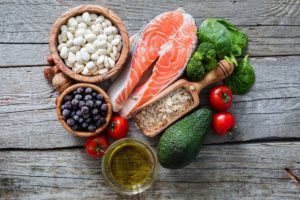
Your body needs some fat to function normally. But it’s wise to choose the healthier types of dietary fat and then enjoy them — in moderation.
The good and the bad
Monounsaturated and polyunsaturated fats are the best choices. Look for products with little or no saturated fats, and avoid trans fats: Both increase blood-cholesterol levels and can increase your risk of heart disease. And keep in mind that all fats — the good stuff as well as the bad — are high in calories, so measuring and moderation are key.
The good:
- Monounsaturated fats are found in olive, canola and peanut oils, as well as in avocados and most nuts.
- Polyunsaturated fats are found in other plant-based oils, such as corn, sunflower, soybean, sesame and cottonseed oils. Omega-3 fats are polyunsaturated fats that help your cells function.
The bad:
- Saturated fats are found in animal-based foods, such as meats, poultry, lard, egg yolks and whole-fat dairy products, including butter and cheese. They’re also in cocoa butter and coconut, palm and other tropical oils, which are used in many coffee lighteners, snack crackers, baked goods and other processed foods.
- Trans fats — also called hydrogenated vegetable oils — are found in hardened vegetable fats, such as stick margarine and vegetable shortening. Lots of foods contain these unhealthy ingredients as well, including crackers, cookies, cakes, pies and other baked goods, as well as many candies, snack foods and french fries.
Choosing foods with the best types of dietary fat
First, focus on reducing foods high in saturated fat, trans fat and cholesterol. Then emphasize food choices that include plenty of monounsaturated fats (MUFAs) and polyunsaturated fats (PUFAs). But a word of caution — don’t go overboard even on healthy fats. All fats, including the healthy ones, are high in calories. So consume MUFA-rich and PUFA-rich foods instead of other fatty foods, not in addition to them.
Here are some tips to help you make over the fat in your diet:
- Use the Nutrition Facts label and ingredient list when selecting foods. Look for the amount of trans fat listed. By law a serving of food containing less than 0.5 grams of trans fat can be labeled as 0 grams. Therefore, it is important to also check the ingredient list rather than just the Nutrition Facts label for the terms trans fat and partially hydrogenated.
- Prepare fish, such as salmon and mackerel, instead of meat at least twice a week to get a source of healthy omega-3 fatty acids. Limit sizes to 4 ounces of cooked seafood a serving, and bake or broil seafood instead of frying.
- Use liquid vegetable oil instead of solid fats. For example, saute with olive oil instead of butter, and use canola oil when baking.
- Use olive oil in salad dressings and marinades.
- Use egg substitutes instead of whole eggs when possible to cut back on the cholesterol in yolks.
- Select milk and dairy products that are low in fat.


